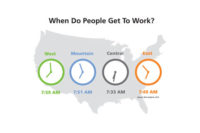How Leveraging Big Data Changes the Perception of Security

- Descriptive analytics interprets historical data to better understand the changes that have happened in a business. It uses past data to draw comparisons or spot trends.
- Diagnostic analytics examines data to determine why something happened.
- Predictive analytics models exploit patterns found in historical and transactional data to identify risks and opportunities. This analysis helps organizations determine a future course of action and figure out what is likely to happen in the future.
- Prescriptive analytics determines the best solution among the various choices given the known parameters. Analysis is based on previously set rules and recommendations, helping organizations figure out what they should do about their data.
Where does the data come from?
Several physical security systems provide data that end users can leverage such as video management systems, access control and visitor management platforms.
As video surveillance systems evolve, they are starting to identify people and objects with increasing accuracy. Video analytics systems can count how many people are in a room, identify them through facial recognition and flag any unusual behavior such as running or walking against a crowd. When a camera can tell if a person is in a room and also what that person is doing, or even where their attention may be focused, this can provide benefits for facilities and marketing departments to better perform their jobs.
An access control system allows people in and out of doors. Think about the many uses for that type of data. Security directors, along with department heads, will know who was in a building, when and possibly for how long. It will provide an employee’s patterns as they move through a building. This is critical during a crisis or while investigating incidents.
An automated visitor management platform allows an organization to gather valuable data from their own customers or visitors. The system can capture how many visitors are in the building, customer or visitor traffic throughout a building, how long they are inside a building and when they leave. A visitor management system can also block unwanted or potentially dangerous visitors from entering a facility. In addition, they can also help companies plan for and greet VIP guests.
How does data benefit different departments?
Physical identity and access management platforms can help human resource departments with onboarding and offboarding. No one should have access to a building until they are an active employee, and access should be immediately removed once terminated.
Studies show that 21 days before an employee quits, they change their patterns. Access control data can predict anomalous behavior. Typically people are responsible for the same thing each day. If their behavior changes, such as a manager starts to be repeatedly late, this could indicate they are planning to resign.
With a greater focus on cybersecurity in organizations, IT departments can see what a person is doing on their PC, but find it’s much more useful when they can tie that to a person’s physical actions. For example, tying metrics of IT logins to physical security system logins and matching them up can show potential issues if someone is logging into the network from a place they are not sitting in.
Facilities departments need information to determine how much real estate is needed to support staffing requirements and building management systems. The data derived from access control systems can measure foot traffic by location and by the time of day. This data can help determine if space needs are being met and if additional resources are required.
“Facility managers can tie access control data to building management systems to automatically turn off lights and turn down the heat when a room has been empty for a period of time, saving on energy costs and environmental impact,” says Jonathan Moore, Product Director for AMAG Technology.
Marketing teams study buyer behavior and need to know how customers select products and services. In a retail environment, in-store video analytics can measure hotspots, traffic flow, dwell time and product display activity. Sensors can provide insights into the customer journey throughout the store, and how to optimize window and display effectiveness. For example, store owners can sell highly valued end cap space. Having the data to show that 80 percent of people stop at a particular end cap space as they walk through the store validates how important that space is, and now makes security a revenue generator.
Warehouse/operations departments care about safety and efficiency. Video analytics can help optimize warehouse production flow, bottlenecks and traffic patterns. It can help with inventory management and detect leaks or spills. Alerts notify department managers of changes in normal behavior.
Legal departments protect the company from fraud, intellectual property theft and trade theft. They are heavily concerned about compliance, NDAs and audits and need to take a proactive approach. Visitor management systems can ensure NDA agreements are in place before a visitor arrives. Identity management systems can sync up compliance requirements with employees. For example, employees who work on the tarmac at an airport must have a large amount of insurance. If an airline employee’s insurance lapses, but they still have access, the airline would have to pay a big fine. An identity management system allows the airlines and other airport tenants to automatically track when insurance premiums are due and when background checks need to be performed.
As more parts of the business use security to benefit their departments, they will look at predictive data analysis with the use of machine learning. This has the ability to spot trends, identify risks and help determine future courses of action.
Collaboration between the different teams is the key to success of any business. Different departments can leverage big data, applying machine learning and AI systems creating actionable data, to improve their performance and in the end, change the perception of the security department to a strategic-thinking, business enabling and income generating department while driving innovation.
Looking for a reprint of this article?
From high-res PDFs to custom plaques, order your copy today!





